Oportun Financial Bundle
How is Oportun Financial Revitalizing the Lending Landscape?
Oportun Financial Corporation has recently demonstrated a remarkable financial turnaround, achieving GAAP profitability in late 2024 and early 2025. This success is particularly noteworthy given its mission to serve low-to-moderate-income individuals, many with limited credit histories. With a significant increase in net income and loan originations, Oportun is proving its strategic approach is effective.
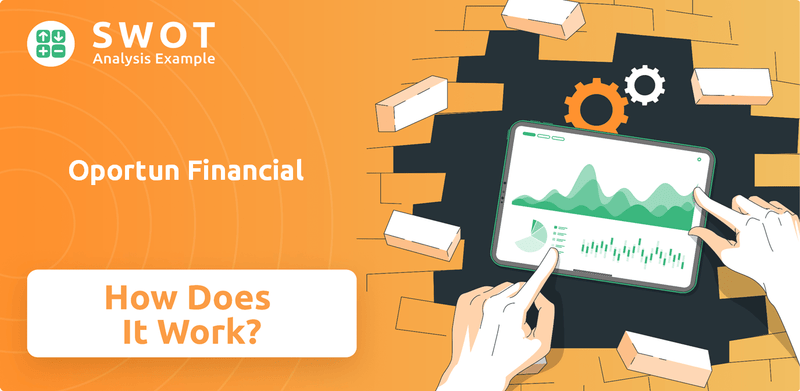
This analysis explores the inner workings of Oportun, examining how it provides Oportun Financial SWOT Analysis and generates revenue. We will delve into the Oportun loans application process, including Oportun interest rates, and eligibility criteria. Understanding the company's operations is crucial for anyone interested in the future of financial inclusion and the performance of Oportun.
What Are the Key Operations Driving Oportun Financial’s Success?
Oportun Financial creates value by offering accessible financial services to individuals often overlooked by traditional institutions. The company focuses on low-to-moderate-income individuals with limited or no credit history. Their core products include unsecured personal loans, secured personal loans (primarily auto-secured), and credit cards, designed to help customers build credit and improve their financial health.
The operational backbone of Oportun relies on its AI-driven technology and credit assessment algorithms. This technology allows for more effective risk assessment and automated savings, incorporating billions of data points, including traditional credit data and alternative transactional information. Oportun serves its customers through a multi-channel approach, including online platforms, over-the-phone services, and a network of retail locations across 24 states.
Oportun's value proposition centers on financial inclusion, providing access to responsible credit and helping individuals build a better financial future. By leveraging technology and data, Oportun aims to offer cost-effective and scalable credit solutions to an underserved market. If you're interested in learning about the company's ownership, you might find the article about Owners & Shareholders of Oportun Financial insightful.
Oportun offers unsecured personal loans, secured personal loans (primarily auto-secured), and credit cards. These products are designed to help customers build credit and improve their financial health. The company focuses on providing accessible financial services to those with limited or no credit history.
Oportun utilizes AI-driven technology and credit assessment algorithms to assess risk and automate savings. This involves ingesting billions of data points, including traditional and alternative credit information. They serve customers through online platforms, over-the-phone services, and retail locations.
Oportun's supply chain includes a diversified capital markets funding program with asset-backed securitizations and committed warehouse facilities. As of March 31, 2025, the company had $317 million of undrawn capacity on its existing $766 million personal loan warehouse lines, committed through September 2027 and August 2028. They also engage in forward flow whole loan sale agreements.
The company aims to enhance financial inclusion by providing access to responsible credit. Oportun helps individuals build a better financial future by offering cost-effective and scalable credit solutions to an underserved market. The focus is on serving low-to-moderate-income individuals.
Oportun's operations are unique due to its deep understanding of its customers and its ability to provide cost-effective credit solutions. This approach translates into several customer benefits, including access to responsible credit and the opportunity to build a better financial future. The company leverages data-driven insights to manage risk and offer tailored financial products.
- AI-Driven Technology: Uses advanced algorithms for credit assessment and risk management.
- Multi-Channel Approach: Offers services through online platforms, phone, and retail locations.
- Financial Inclusion: Focuses on serving low-to-moderate-income individuals.
- Data-Driven Insights: Leverages billions of data points for better decision-making.
Oportun Financial SWOT Analysis
- Complete SWOT Breakdown
- Fully Customizable
- Editable in Excel & Word
- Professional Formatting
- Investor-Ready Format
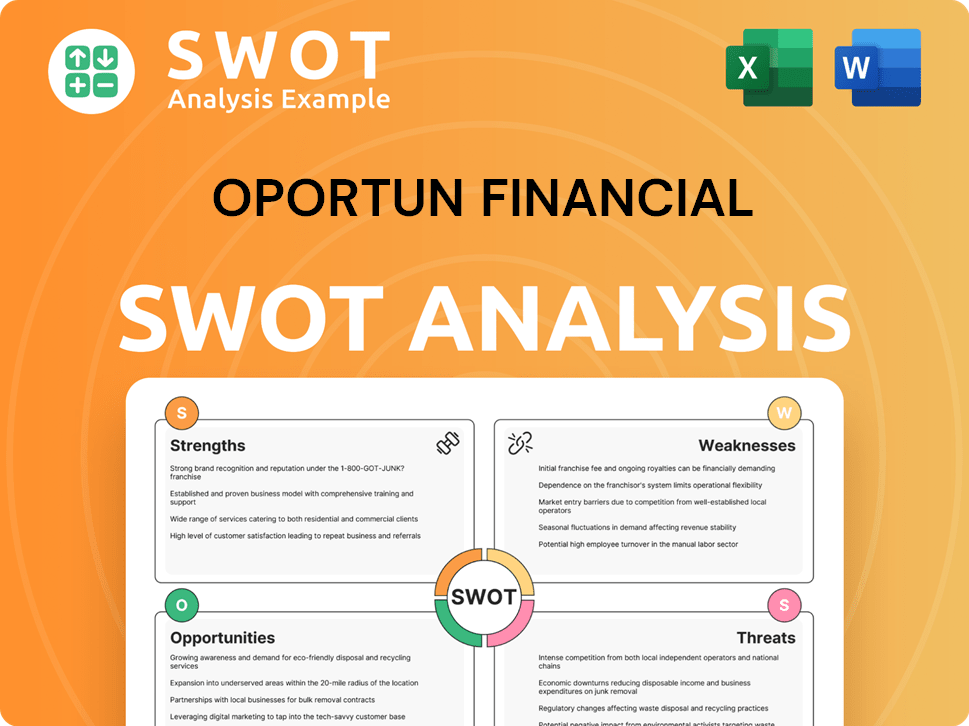
How Does Oportun Financial Make Money?
Revenue generation for Oportun Financial primarily stems from interest earned on its loan portfolio and fees associated with its financial products and services. The company strategically employs various monetization strategies to optimize profitability and manage risk. These strategies include diversifying loan products and expanding its market reach through partnerships.
In Q1 2025, Oportun Financial reported a total revenue of $236 million. For the full year 2024, the total revenue was $1 billion. The company's portfolio yield in Q1 2025 was 33.0%, an increase from 32.5% in the prior year's quarter, driven by higher loan pricing.
Historically, unsecured personal loans have been a major source of revenue. However, Oportun Financial is shifting towards secured personal loans, which had approximately 500 basis points lower losses compared to unsecured personal loans in 2024. This shift is expected to improve profitability and reduce risk.
The main revenue stream for Oportun comes from the interest charged on the loans it provides. Additional revenue is generated through various fees associated with the loan products and services offered.
A key strategy involves increasing the proportion of secured personal loans. Secured loans are expected to generate approximately twice the revenue per loan compared to unsecured loans, primarily due to larger average loan sizes.
The 'Lending as a Service' program is another monetization strategy. This involves partnerships with other consumer brands to expand reach and originate loans through existing channels.
Cost management is also a focus. Operating expenses decreased by 15% year-over-year in Q1 2025, contributing to improved profitability.
The company has taken steps to exit unprofitable products. The sale of its credit card portfolio in November 2024 is expected to positively impact adjusted EBITDA in 2025.
The company's focus on secured loans, along with strategic partnerships and cost management, is designed to improve its financial performance. For more insights, explore the Marketing Strategy of Oportun Financial.
The company's approach to revenue generation and profitability involves a mix of interest income, fees, and strategic initiatives.
- Interest Income: Primarily from loans.
- Fees: Associated with loan products and services.
- Secured Loans: Focus on secured loans to reduce risk and increase revenue per loan.
- Lending as a Service: Partnerships to expand loan origination.
- Cost Management: Reducing operating expenses to improve profitability.
Oportun Financial PESTLE Analysis
- Covers All 6 PESTLE Categories
- No Research Needed – Save Hours of Work
- Built by Experts, Trusted by Consultants
- Instant Download, Ready to Use
- 100% Editable, Fully Customizable
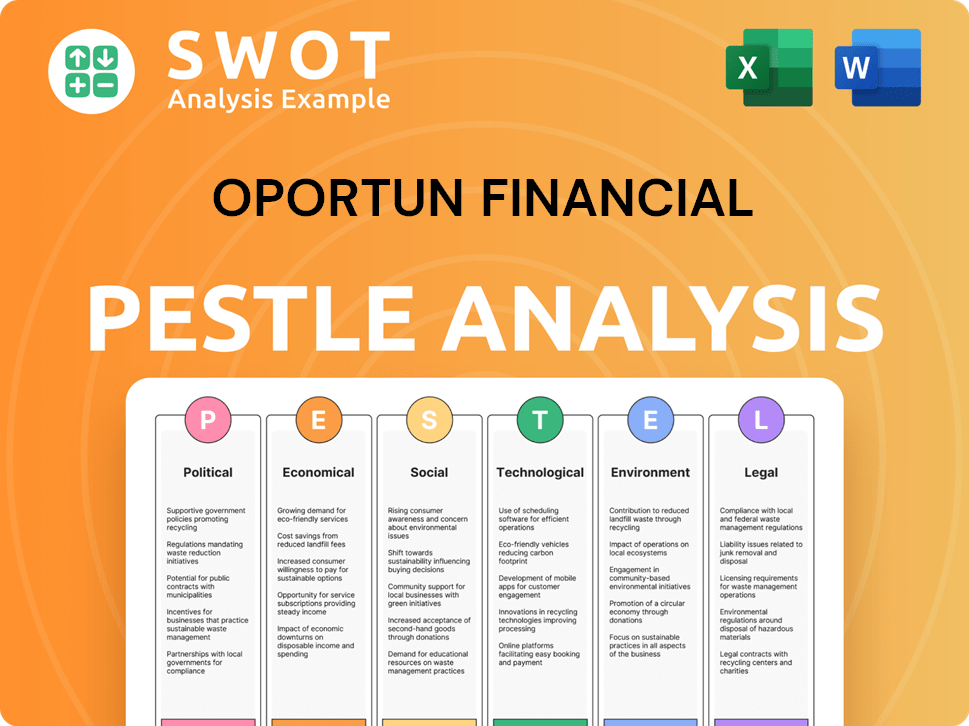
Which Strategic Decisions Have Shaped Oportun Financial’s Business Model?
Oportun Financial has marked significant milestones since its inception in 2005, notably extending over $20.3 billion in responsible credit through more than 7.4 million loans and credit cards. The company's strategic moves include the introduction of secured personal loans in April 2020, expanding its product offerings. A key recent development is the return to GAAP profitability, demonstrating resilience and strategic adaptation.
Operational challenges have prompted strategic adjustments. These include cost-reduction initiatives, such as a 15% year-over-year reduction in operating expenses in Q1 2025 and a 12% reduction in corporate staff in March 2024, alongside the closure of 39 retail locations. The company has also refined its credit model, resulting in improved delinquency and net charge-off rates.
Oportun's competitive edge stems from its focus on underserved markets, particularly the Hispanic community, leveraging AI-driven credit assessment models. Its diversified funding program, including asset-backed securitizations, further strengthens its position. Oportun continues to adapt by focusing on improving credit outcomes and strengthening business economics, with a strategic emphasis on secured personal loans. You can learn more about the company's background in this Brief History of Oportun Financial.
Oportun has provided over $20.3 billion in credit through more than 7.4 million loans and credit cards. The introduction of secured personal loans in April 2020 was a crucial product launch. The company returned to GAAP profitability in Q4 2024 and Q1 2025, with a net income of $9.8 million in Q1 2025.
Oportun has implemented cost-reduction measures, including a 15% year-over-year reduction in operating expenses in Q1 2025 and a 12% reduction in corporate staff in March 2024. The company closed 39 retail locations. Refined credit models have led to improved delinquency rates and net charge-offs.
Oportun focuses on underserved markets, especially the Hispanic community. It uses AI-driven credit assessment models for effective risk evaluation. The company has a diversified funding program, including asset-backed securitizations with AAA ratings. The annualized net charge-off rate was 12.2% in Q1 2025, at the low end of guidance.
Oportun's return to profitability in Q1 2025, with a net income of $9.8 million, demonstrates its financial turnaround. The company's strategic cost-cutting measures, including a 15% reduction in operating expenses, have positively impacted its financial health. The focus on secured personal loans is a key strategic direction.
Oportun's strategic moves and competitive advantages are pivotal to its success. The company's ability to adapt to market changes and maintain a focus on underserved markets differentiates it from competitors. The focus on improving credit outcomes and strengthening business economics is a key strategy.
- Extended over $20.3 billion in responsible credit.
- Introduced secured personal loans in April 2020.
- Achieved GAAP profitability in Q4 2024 and Q1 2025.
- Implemented cost-reduction initiatives and refined credit models.
Oportun Financial Business Model Canvas
- Complete 9-Block Business Model Canvas
- Effortlessly Communicate Your Business Strategy
- Investor-Ready BMC Format
- 100% Editable and Customizable
- Clear and Structured Layout
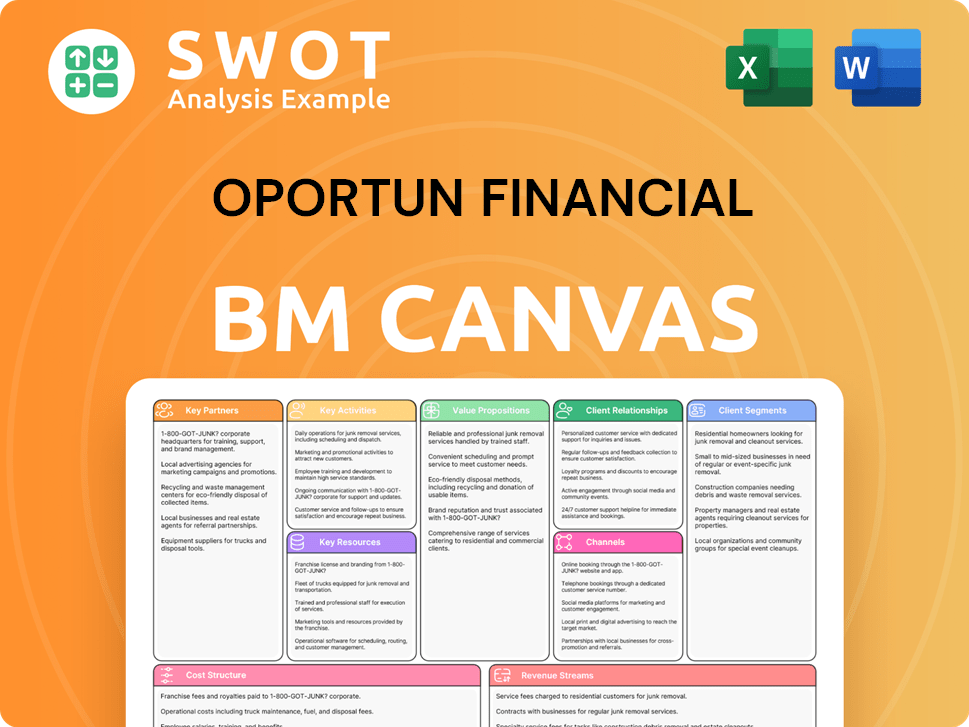
How Is Oportun Financial Positioning Itself for Continued Success?
Oportun Financial holds a unique position in the financial services industry, focusing on low-to-moderate-income individuals often overlooked by traditional lenders. Since its inception, Oportun has provided over $20.3 billion in responsible credit, demonstrating its significant reach within its target demographic. The company operates in 24 states, utilizing both online and retail channels to serve its customers.
However, Oportun faces risks such as macroeconomic conditions like fluctuating inflation and interest rates, which can affect its financial results. The company also faces competition and regulatory changes. Despite these challenges, Oportun has shown improved credit metrics in Q1 2025, with a 30+ day delinquency rate of 4.7%, down from 5.2% in the prior-year quarter.
Oportun specializes in serving the underserved, targeting low-to-moderate-income individuals with limited credit history. This focus sets it apart from traditional lenders. They provide financial services in 24 states, utilizing online and retail channels.
Key risks include macroeconomic factors like inflation and interest rates, which can impact interest rate spreads. Increases in loan non-payments and delinquencies also pose a risk. Oportun is also subject to competition and regulatory changes.
Oportun is focused on sustaining and expanding its profitability. The company aims to increase lending on a secured basis and expand its store network. Strategic initiatives include improving credit outcomes and maintaining tight expense controls.
Oportun has reiterated its full-year 2025 Adjusted EPS guidance of $1.10 to $1.30 per share, implying growth of 53% to 81%. The company expects operating expenses to decrease in 2025 due to workforce diversification and reduced vendor spend.
Oportun is working on several strategic initiatives to boost its performance. These include improving credit outcomes and increasing loan portfolio yield. The company also plans to enhance cross-buying opportunities between its savings and credit products.
- Increasing the percentage of lending on a secured basis.
- Expanding its store network into new states.
- Growing its Lending as a Service lead generation program.
- Focusing on operational efficiency by reducing costs.
For more insights into how Oportun compares to its competitors, consider reading Competitors Landscape of Oportun Financial.
Oportun Financial Porter's Five Forces Analysis
- Covers All 5 Competitive Forces in Detail
- Structured for Consultants, Students, and Founders
- 100% Editable in Microsoft Word & Excel
- Instant Digital Download – Use Immediately
- Compatible with Mac & PC – Fully Unlocked
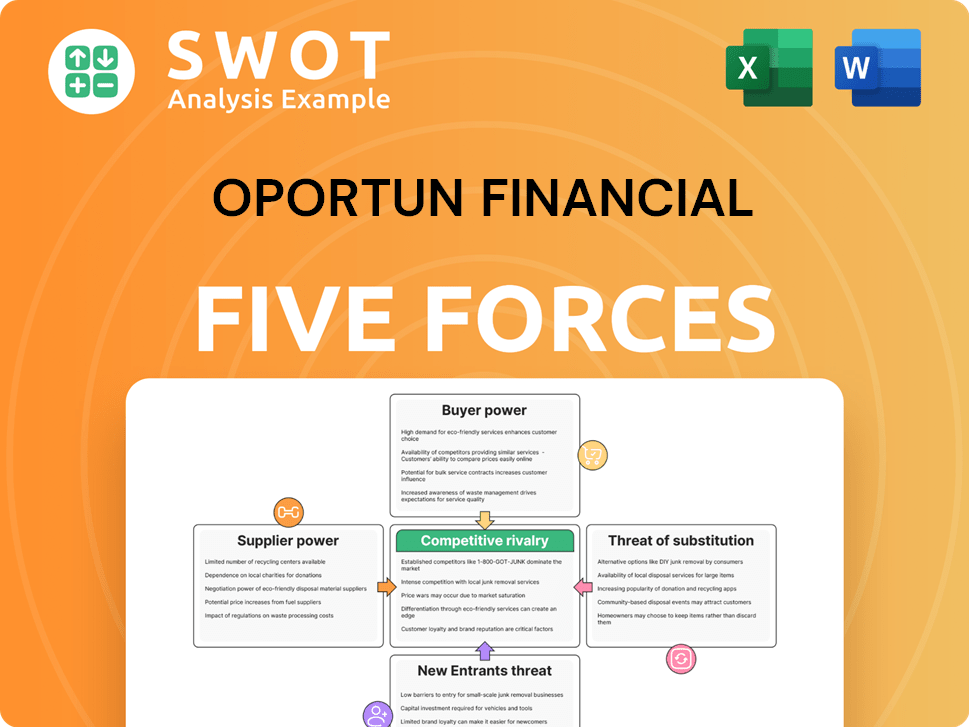
Related Blogs
- What are Mission Vision & Core Values of Oportun Financial Company?
- What is Competitive Landscape of Oportun Financial Company?
- What is Growth Strategy and Future Prospects of Oportun Financial Company?
- What is Sales and Marketing Strategy of Oportun Financial Company?
- What is Brief History of Oportun Financial Company?
- Who Owns Oportun Financial Company?
- What is Customer Demographics and Target Market of Oportun Financial Company?
Disclaimer
All information, articles, and product details provided on this website are for general informational and educational purposes only. We do not claim any ownership over, nor do we intend to infringe upon, any trademarks, copyrights, logos, brand names, or other intellectual property mentioned or depicted on this site. Such intellectual property remains the property of its respective owners, and any references here are made solely for identification or informational purposes, without implying any affiliation, endorsement, or partnership.
We make no representations or warranties, express or implied, regarding the accuracy, completeness, or suitability of any content or products presented. Nothing on this website should be construed as legal, tax, investment, financial, medical, or other professional advice. In addition, no part of this site—including articles or product references—constitutes a solicitation, recommendation, endorsement, advertisement, or offer to buy or sell any securities, franchises, or other financial instruments, particularly in jurisdictions where such activity would be unlawful.
All content is of a general nature and may not address the specific circumstances of any individual or entity. It is not a substitute for professional advice or services. Any actions you take based on the information provided here are strictly at your own risk. You accept full responsibility for any decisions or outcomes arising from your use of this website and agree to release us from any liability in connection with your use of, or reliance upon, the content or products found herein.